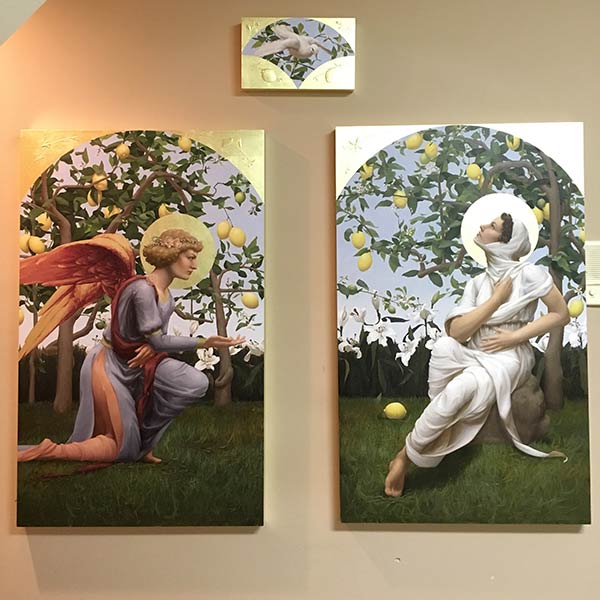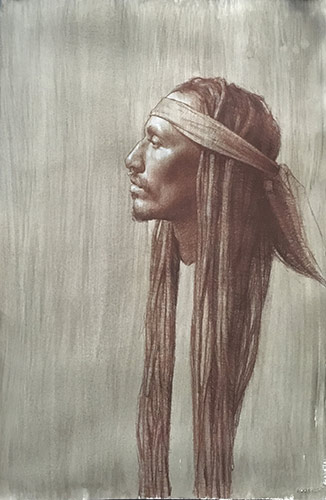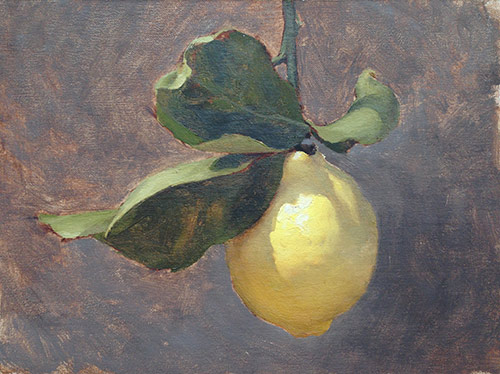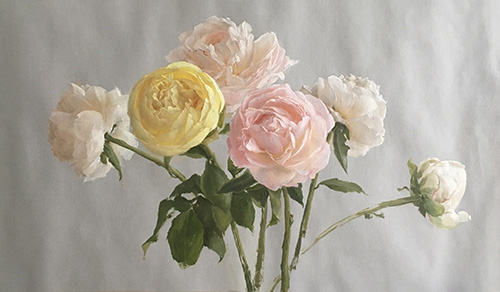Fine Art Today recently caught up with the magnificent and quickly ascending painter Katie G. Whipple for an in-depth inquiry into the woman, the artist, and her paintings. Her responses were attentive, complete, and sure to intrigue our readers. They deserved to be quoted in full.
Fine Art Today: Talk to us a little about your creative process. Once a moment of inspiration hits, how do you approach the panel or canvas? How do you know when a piece is completed?
Katie Whipple: In some sense, every piece I make has a completely different process. But to my students or an outside observer, it probably doesn’t seem that way. What I mean is that I tend to start my pieces in a similar fashion: a drawing, an underpainting, then the final pass or passes. But to me, each piece feels like completely uncharted territory, even if I have been painting the same subject matter for weeks or months. Inspiration comes from infinite sources, and the initial spark of an idea is what tends to guide my process for the painting.
Lately, I have been painting lots of flowers. Because I am such a slow painter and like to paint many-petaled flowers, I have a painting rate of about one flower per day. This is not a very sustainable pace if you are trying to paint a bouquet of live flowers. I decided to start composing my paintings one flower at a time, adapting my subject matter to my limited skill and speed. This saved me money on flowers and allowed me to get my desired effect for creating a bigger composition.
Of course, when working in this “in the moment” kind of painting style, I have no idea where the composition is heading when I paint that first flower on the canvas. I know it is completed when I have added enough flowers to make a composition work (there is always a scary point where this doesn’t seem possible) and can’t add anything else to the composition without breaking the integrity of the piece. Or sometimes paintings are finished when you simply run out of time! Honestly, though, I hate finishing paintings. It always seems to me as if a complete canvas is just whispering to me, “Well, you tried your best. Don’t worry kid, you’ll get ’em next time.”

Fine Art Today: Is there something specific that draws you to your subjects, such as the figure? What has this evolution been like?
Katie Whipple: I decided I wanted to be a professional artist around age 12. I had been drawing and painting all my life, and already was taking oil painting lessons by that point. My mother is a very talented, mostly self-taught painter who started encouraging my interest in art at a very early age. But it was at age 12, in 2003, when I saw the Richard Schmid retrospective at the Butler Museum in Youngstown, Ohio, that I thought I could make this my life. I especially remember his paintings of his family and how much they moved me, even at that young age.
Around this same time, I realized I could copy a picture from a magazine and actually make it look like the person. So began my love affair with drawing faces. My love of drawing and the desire to master the human form led me to Jacob Collins and the Grand Central Atelier in New York City. In my four years of study at GCA I was completely devoted to studying the human form. It was the only thing I cared to draw or paint, and it was my highest aspiration to be a portrait painter.
I still deeply love painting and drawing the figure, and it attracts me for the same reasons it attracts all of us: because we are human beings. We will always, always be most attracted to a painting that reflects ourselves. A Rembrandt portrait can communicate to us about love, loss, perseverance, devastation, strength, and compassion equally with 1,000 pages of Victor Hugo. This will always be one of the reasons I paint. Now, to be rather contradictory, it is for similar reasons that I have stepped away from the figure for the last several months of my life, and am focusing on some new channels to let inspiration speak through.
Fine Art Today: What are your primary goals in art, and what do you hope your viewers take away from it?
Katie Whipple: A perfect follow-up to the last question, and the answer [to] why I am taking a break from portraits and figures at this point in my career. Right now, my primary goal in my paintings is to create joy and delight. This is much harder to do with painting people than it is with painting flowers. To me, flowers are the embodiment of Nature’s joy. They are pure beauty, pure delight. We humans have cultivated and selectively bred the flowers for centuries — for no other reason than to make them the most beautiful, the most fragrant, and the most lovely.
We attach so very much emotion to a face or human form. I found I was doing this in my own work and it seemed to be clouding my vision and making me take myself way too seriously — I am just a painter, after all. You can never look at a portrait of anyone objectively, no matter how long ago it was painted. So, for now, and I do hope this will change if you ask me this question a year from now, I hope that my viewers take away the same delight in my paintings that I feel in making them.

Fine Art Today: Which artists have been the most influential for you? Whether historical or contemporary, is it purely an aesthetic influence or conceptual? Perhaps both?
Katie Whipple: Oh, this question! I know every artist has a thousand different answers every day of the week! Right now, my biggest influences are Odilon Redon, Roman wall paintings, and Golden Age botanical illustrations. Redon for his sheer delight in creation and his incredible use of floral motif. Roman wall paintings because they are masterpieces, and consume me to tears, wonder, and speechlessness every time I walk into a room of them — but most specifically the “Painted Garden” from the Villa Livia. It is (right now) my favorite painting, and of course we have no idea who painted it. And botanical illustrations because they are teaching me so much and are so incredibly fun to look at.
As far as my “Mount Rushmore” of artists, as my father would say, this is a different batch altogether. Michelangelo, Rembrandt, Fra Angelico, and Van Gogh. Simply because they were all geniuses and because they are the four artists that never fail to bring me to tears. Hans Holbein is pretty high up there as well. Fra Angelico, though, is my dear friend, and his pieces have an effect on me like no piece of art ever has. I wasn’t raised Catholic and am not particularly religious, so I can’t really explain this except to say that his paintings touch my soul in a way that is completely unexplainable.
Influential contemporary artists, of course, are my wonderful teachers, mentors, and friends. Firstly, Edward Minoff, because I firmly believe I wouldn’t know how to paint or draw at all without his guidance over the years. And Jacob Collins, to whom I owe so much. As well as some of my very favorite artists that I am lucky enough to call my teachers, friends, and colleagues: Colleen Barry, Travis Schlaht, Will St. John, Patrick Byrnes, Liz Beard, and my husband, Brendan Johnston.
There are so many more to include!

Fine Art Today: Your surfaces are so incredibly lovely. They have a such an attentiveness, vitality, and warmth. How important are these — and other — surfaces in your work?
Katie Whipple: Thank you! Oh, I’m so glad you asked this question, because I am so excited about my surfaces! When I was living and studying Old Masters in Italy in 2013-14, I started painting on wood panels because I was copying Renaissance paintings. I completely fell in love with working on oil-primed wood, and I have hardly painted on canvas since!
Surface is important because it completely changes the application of the paint and the effects you are able to achieve. I love working on wood because I am able to lay down a brushstroke and the integrity of the stroke will hold, no matter how transparent or opaque that stroke is. I also love the ability to achieve more translucent effects with a smooth, hard surface — perfect for painting flowers.
As far as the gold leaf goes, you don’t have to work on panel to gild a surface, but for me it is one way to cut framing costs and make a piece complete within itself — just like altarpieces in the Renaissance. Also, I like to add very low gesso reliefs to my works to gild over and create a “frame” for the piece; this can only be done on a hard surface, otherwise the built-up gesso would crack.
Small shout-out, I custom-order my panels from SoHo Art Materials; they are so beautiful, and I very highly recommend them. And I prime the raw wood panels with two layers of rabbitskin glue, and two layers of lead ground from Natural Pigments. I couldn’t dream of a more beautiful surface to work on!

Fine Art Today: Talk to us about your journey to becoming an artist. Were you always interested in art?
Katie Whipple: I think I made my first watercolor painting at age 4, and I can’t remember a time when I wasn’t painting or making something with my hands. I have always loved art, and other than a brief time of wanting to be a veterinarian when I was 9, it has really been my only desired career path.
I have been incredibly lucky in my artistic journey. My parents have always supported and believed in me and encouraged me to make a career in art. My mom always took me to museums and art lectures as a child, which I loved. When I was 18, I moved to New York City right after graduating high school to attend what was then the Grand Central Academy in Manhattan — now Grand Central Atelier in Queens. At the time I knew hardly anything about the atelier movement, or academic painting in general. I had certainly never heard of the Ecole de Beaux Arts.
All I knew is that I wanted to learn how to draw really well, and I was completely blown away by the work I saw at GCA. I am so incredibly grateful to my 18-year-old self for taking the plunge into the unknown. In being at GCA and living in New York City for four years, many things were opened up to me, and I learned much more than how to draw. I am so grateful for Jacob’s vision in this; during my first years at the GCA I heard lectures that included Shakespeare and classical violin concerts, as well as lectures about Brunelleschi and the Golden Ratio. I leaned into my love of history and learned more about all kinds of painting.
After graduating GCA, I received the Alma Schapiro Prize, which sent me to live at the American Academy in Rome for three months. My husband (then boyfriend) and I stayed for eight months, traveling to Florence, Naples, and the Amalfi Coast. This time in Italy might be one of the most shaping events for where my career is today, for that is where I fell in love with the Renaissance, Roman wall painting, and painting fruits and flowers. It is also where I learned to cultivate pure delight in my work and in my studio practices.

Fine Art Today: Where do you see yourself in, say, five years? How do you see your career and artworks evolving?
Katie Whipple: I have no idea! I would hate to know where I am going to be in five years. I hope that I will be painting, that I will be happy, and that I will continue to surprise myself with what I choose to paint, or not to paint. Right now, my highest hope is that my paintings make the viewer feel like listening to Mozart makes me feel. For me, there is no higher aspiration than to touch people’s spirit with my work, and to make them feel that, despite the hardships and the ugliness, the world is beautiful.
To learn more about this incredible artist, visit her website here.
This article was featured in Fine Art Today, a weekly e-newsletter from Fine Art Connoisseur magazine. To start receiving Fine Art Today for free, click here.








This art site,,,is a wonderful palce for an artist who is interested in all kinds of art, and art making….I joined a long time ago,,,but never took the time to really see beyond the front page….until I saw the Light house and the story of “Poppy’s favorite place to paint”….this week Is the first time that I went back to see what Andrew Webster was really up to….I am so impressed with what he brings to the artist to be incourgaged by and be visually stimulated from…what other people are doing. Thanks, so much Mr. Webster